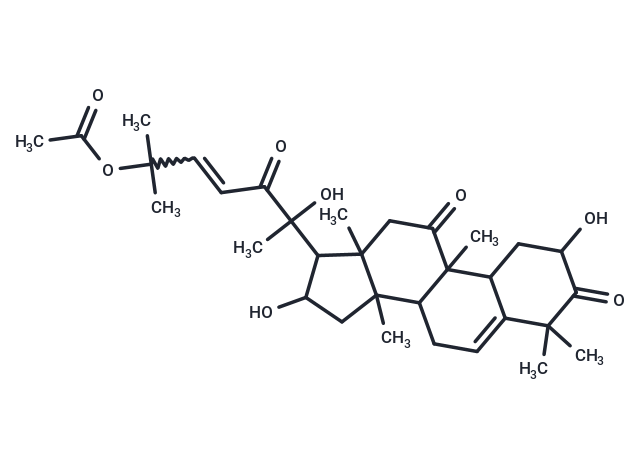Shopping Cart
- Remove All

Your shopping cart is currently empty


| Pack Size | Price | Availability | Quantity |
|---|---|---|---|
| 1 mg | $44 | In Stock | |
| 5 mg | $97 | In Stock | |
| 10 mg | $167 | In Stock | |
| 25 mg | $337 | In Stock | |
| 50 mg | $597 | In Stock | |
| 100 mg | $798 | In Stock | |
| 1 mL x 10 mM (in DMSO) | $119 | In Stock |
| Description | Cucurbitacin B (Cuc B) has profound in vitro and in vivo antiproliferative effects against human pancreatic Y cells. It inhibited AKT signaling activation through up-regulation of PTEN. Cucurbitacin B is an effective inhibitor of HIF-1 and provide new perspectives into the mechanism of its anticancer activity. Cucurbitacin B inhibits proliferation and induces apoptosis via STAT3 pathway inhibition in A549 lung Y cells. |
| In vitro | Cucurbitacin B inhibits the growth of 5 GBM cell lines: U87, U118, U343, U373 and T98 g by affecting the cytoskeleton and the JNK pathway, with ED50 ranged from 5 nM to 100 nM. Cucurbitacin B also causes cell cycle arrest at the G2/M phase, decreases cell migration and induces apoptosis of GBM cells. [1] In human breast cancer cell lines, Cucurbitacin B also inhibits cell growth with ED50 varied from 30.3 nM to 418 nM, and rapidly induces cytoskeletal disruption. [2] In addition, Cucurbitacin B possesses immunomodulatory and anti-inflammatory effects, depending on the induction of heme oxygenase-1 expression via Nrf2 activation. [3] |
| In vivo | In nude mice bearing MDA-MB-231 tumors, Cucurbitacin B (1 mg/kg, i.p.) inhibits tumor growth by 55 %, and causes lower serum glucose levels. [2] |
| Cell Research | For proliferation measurements, the cells are placed into 96 well plates, and cell growth is measured at various times by MTT assay according to the protocol.(Only for Reference) |
| Alias | Cuc B, DATISCACIN, Amarine |
| Molecular Weight | 558.7 |
| Formula | C32H46O8 |
| Cas No. | 6199-67-3 |
| Storage | Powder: -20°C for 3 years | In solvent: -80°C for 1 year | Shipping with blue ice. | ||||||||||||||||||||||||||||||||||||||||
| Solubility Information | DMSO: 91 mg/mL (162.9 mM) Chloroform, Dichloromethane, Ethyl Acetate: Soluble Ethanol: 50 mg/mL (89.49 mM) | ||||||||||||||||||||||||||||||||||||||||
Solution Preparation Table | |||||||||||||||||||||||||||||||||||||||||
Ethanol/DMSO
DMSO
| |||||||||||||||||||||||||||||||||||||||||

Copyright © 2015-2024 TargetMol Chemicals Inc. All Rights Reserved.